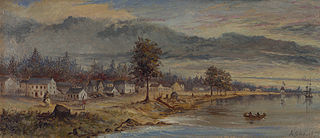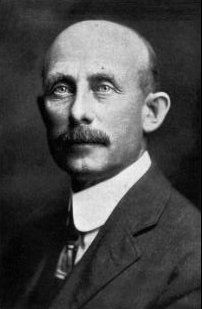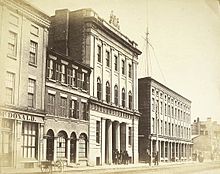
Brantford is a city in Ontario, Canada, founded on the Grand River in Southwestern Ontario. It is surrounded by Brant County, but is politically separate with a municipal government of its own that is fully independent of the county's municipal government.

York was a town and second capital of the colony of Upper Canada. It is the predecessor to the old city of Toronto (1834–1998). It was established in 1793 by Lieutenant-Governor John Graves Simcoe as a "temporary" location for the capital of Upper Canada, while he made plans to build a capital near today's London, Ontario. Simcoe renamed the location York after Prince Frederick, Duke of York and Albany, George III's second son. Simcoe gave up his plan to build a capital at London, and York became the permanent capital of Upper Canada on February 1, 1796. That year Simcoe returned to Britain and was temporarily replaced by Peter Russell.

High Park is a municipal park in Toronto, Ontario, Canada. High Park is a mixed recreational and natural park, with sporting facilities, cultural facilities, educational facilities, gardens, playgrounds and a zoo. One-third of the park remains in a natural state, with a rare oak savannah ecology. High Park was opened to the public in 1876 and is based on a bequest of land from John George Howard to the City of Toronto. It spans 161 hectares and is the second-largest municipal park in Toronto, after Centennial Park.

George Stewart Henry was a farmer, businessman and politician in Ontario, Canada. He served as the tenth premier of Ontario from 1930 to 1934. He had acted as minister of highways while Ontario greatly expanded its highway system. Henry continued the expansion as premier, but his party did not provide relief during the Great Depression and lost the 1934 election.

CFRB is a commercial AM radio station in Toronto, Ontario, Canada. It is owned by Bell Media and carries a News/Talk radio format. Its studios and offices are in the Entertainment District at 250 Richmond Street West.

King's Highway 3, commonly referred to as Highway 3, is a provincially maintained highway in the Canadian province of Ontario which travels parallel to the northern shoreline of Lake Erie. It has three segments, the first of which travels from the Ambassador Bridge in Windsor to Highway 77 in Leamington. The second portion begins at Talbotville Royal outside of St. Thomas at Highway 4, and travels to the western city limits of Port Colborne. The road is regionally maintained within Port Colborne as Niagara Regional Road 3, but regains its provincial designation at Highway 140. Its third and final terminus is at Edgewood Park, within the Fort Erie town limits. From there, the road continues as Niagara Regional Road 3 to the Peace Bridge, where drivers can cross to the United States. The total length of Highway 3 is 258.2 km (160.4 mi), consisting of 49.2 km (30.6 mi) from Windsor to Leamington, 187.9 km (116.8 mi) from Talbotville Royal to Port Colborne and 21.1 km (13.1 mi) from Port Colborne to Edgewood Park.

Path is a network of underground pedestrian tunnels, elevated walkways, and at-grade walkways connecting the office towers of Downtown Toronto, Ontario, Canada. It connects more than 70 buildings via 30 kilometres (19 mi) of tunnels, walkways, and shopping areas. According to Guinness World Records, Path is the largest underground shopping complex in the world, with 371,600 square metres (4,000,000 sq ft) of retail space which includes over 1,200 retail fronts (2016). As of 2016, over 200,000 residents and workers use the Path system daily with the number of private dwellings within walking distance at 30,115.

The Don Jail was a jail in Toronto, Ontario, Canada, located to the east of the Don River, on Gerrard Street East in the Riverdale neighbourhood. The original building was completed in 1864 and was reopened in 2013 to serve as the administrative wing of Bridgepoint Active Healthcare, a rehabilitation hospital located adjacent to the jail. Prior to its adaptive reuse as part of a healthcare facility, the building was used as a provincial jail for remanded offenders and was officially known as the Toronto Jail. The jail originally had a capacity of 184 inmates, and it was separated into an east wing for the men and a west wing for the women.

Sunnyside is a lakefront district in Toronto, Ontario, Canada. It includes a beach and park area along Lake Ontario's Humber Bay, from west of Exhibition Place to the mouth of the Humber River. The area has several recreation uses, including rowing clubs, sports clubs, picnic areas, playgrounds, a nightclub, a bathing pavilion and public pool. The area is a 3 kilometres (1.9 mi) long strip along the lakeshore, bounded by the Gardiner Expressway and rail lines, which separate it from the Parkdale, Roncesvalles and Swansea neighbourhoods to the north. The name originates in a local farm owned by John Howard, which was situated just to the north, on the location of the current St. Joseph's Health Centre hospital.

The Omni King Edward Hotel is a historic luxury hotel in Downtown Toronto, Ontario, Canada. The hotel is located at 37 King Street East, and it occupies the entire block bounded by King Street on the north, Victoria Street on the east, Colborne Street on the south and Leader Lane on the west.

Trader's Bank Building is a 15-storey, 55.39 m (181.7 ft) early skyscraper, completed in 1906 at 67 Yonge Street in Toronto, Ontario, Canada. The building was designed by Carrère and Hastings, with construction beginning in 1905. It was the tallest building in the British Commonwealth until the Royal Liver Building was completed in 1911. It remains one of Canada's few surviving skyscrapers of the early 20th Century.

The King Street Gaol was Toronto's first jail, built in 1798 on the outskirts of York, Upper Canada. A log structure with 10 cells and a hanging yard, it was located on the south-east corner of King Street and Yonge Street, where the King Edward Hotel stands today. The jail quickly fell into disrepair, leading it to be abandoned. The east cells of the jail were completely rotten, the ceilings in the different rooms were insufficient, and the sheriff didn't feel safe when having to confine prisoners in cells or debtor's rooms. It was replaced by a brick jail in 1824.

BNN Bloomberg is a Canadian English language specialty channel owned by Bell Media. It broadcasts programming related to business and financial news and analysis. The channel is headquartered at 299 Queen Street West in Downtown Toronto.

The second King Street Gaol was built in 1824 to replace the first King Street Gaol in York, Upper Canada. At that time, the town needed a larger, better constructed jail to replace the original, which was little more than a plain log building with a stockade.

750 Burrard Street is a building in Downtown Vancouver, British Columbia, Canada, at the northeast corner of Robson Street and Burrard Street.

The Empress Hotel was a three-storey red-brick building at the corner of Yonge and Gould streets in downtown Toronto. It was destroyed by fire on January 3, 2011. The hotel was opened in 1888. The hotel changed hands several times. The property ceased operating as a hotel in the mid-1970s.

Colborne Street is a street running several hundred metres east of Yonge Street in downtown Toronto, Ontario, Canada. It crosses Victoria Street and Leader Lane, ending at Church Street. It is located between and parallel to King Street East and Wellington Street East. The street is notable for retaining several historic buildings built during the reign of Queen Victoria.

The Milburn building was built in 1886 at 47-55 Colborne Street, in Toronto, Ontario, Canada, by architect Edward James Lennox. Lennox was well known for his work in Toronto for his work on more famous buildings like Casa Loma and Toronto's old city hall.
Claudio Aprile is a Uruguayan–Canadian celebrity chef, restaurateur, cookbook author, and TV personality of Italian descent best known for serving as a main host/judge on CTV's culinary competition MasterChef Canada since January 2014. Having owned and worked at multiple Michelin-starred restaurants over the years, he recently served as the head chef, owner and manager of the acclaimed Toronto restaurant Copetin from its grand opening in July 2017 until its closure in March 2019. In the fall of 2019, Aprile opened up a new restaurant named Xango Toronto, which he presently serves as the owner, restaurateur and head chef of since the closing of Copetin, Colborne Lane and the Origin chain.


















